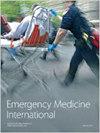Clinical Implications of the Lung Ultrasound Score in Patients after Cardiopulmonary Resuscitation
IF 0.8
4区 医学
Q3 EMERGENCY MEDICINE
引用次数: 0
Abstract
Background. Lung ultrasound score (LUS) is a clinical index used to measure lung injury, but its clinical value in patients after cardiopulmonary resuscitation (CPR) remains relatively unknown. The purpose of this study was to investigate the clinical value of LUS in patients after CPR. Methods. This retrospective study included a total of 34 patients older than 18 years with a nontraumatic cause of in-hospital cardiac arrest, who received standard resuscitation and achieved return of spontaneous circulation (ROSC). All patients underwent bedside lung ultrasound examination within half an hour once ROSC was achieved, and LUSs were calculated. The study included patient death as the endpoint event. Results. Compared with the group with lower LUSs, the patients with higher LUSs had a lower oxygenation index, longer duration of CPR, and lower 72 h survival rate. The initial LUS had good clinical value in predicting the secondary outcomes of CPR (adjusted odds ratio (aOR): 1.353, 95% confidence interval (CI): 1.018–1.797, and = 0.037) and 72 h survival rate of patients who underwent CPR (aOR: 1.145, 95% CI: 1.014–1.294, and = 0.029). Conclusions. LUS was shown to be helpful and had a prognostic value in patients after CPR.心肺复苏后患者肺部超声评分的临床意义
背景。肺部超声评分(LUS)是一项用于测量肺损伤的临床指标,但其在心肺复苏(CPR)后患者中的临床价值仍相对未知。本研究旨在探讨 LUS 在心肺复苏术后患者中的临床价值。方法。这项回顾性研究共纳入了 34 名年龄在 18 岁以上、非创伤性原因导致的院内心脏骤停患者,他们都接受了标准复苏并实现了自主循环(ROSC)的恢复。所有患者均在 ROSC 恢复后半小时内接受了床旁肺部超声检查,并计算了 LUS。研究将患者死亡作为终点事件。研究结果与 LUS 值较低的一组相比,LUS 值较高的患者氧合指数较低,心肺复苏时间较长,72 小时存活率较低。初始 LUS 在预测心肺复苏的次要结果(调整后比值比 (aOR):1.353,95% 置信区间 (CI):1.018-1.797,和 = 0.037)和接受心肺复苏患者的 72 小时存活率(aOR:1.145,95% CI:1.014-1.294,和 = 0.029)方面具有良好的临床价值。结论LUS 对心肺复苏后的患者有帮助并具有预后价值。
本文章由计算机程序翻译,如有差异,请以英文原文为准。
求助全文
约1分钟内获得全文
求助全文
来源期刊

Emergency Medicine International
EMERGENCY MEDICINE-
CiteScore
0.10
自引率
0.00%
发文量
187
审稿时长
17 weeks
期刊介绍:
Emergency Medicine International is a peer-reviewed, Open Access journal that provides a forum for doctors, nurses, paramedics and ambulance staff. The journal publishes original research articles, review articles, and clinical studies related to prehospital care, disaster preparedness and response, acute medical and paediatric emergencies, critical care, sports medicine, wound care, and toxicology.
 求助内容:
求助内容: 应助结果提醒方式:
应助结果提醒方式:


